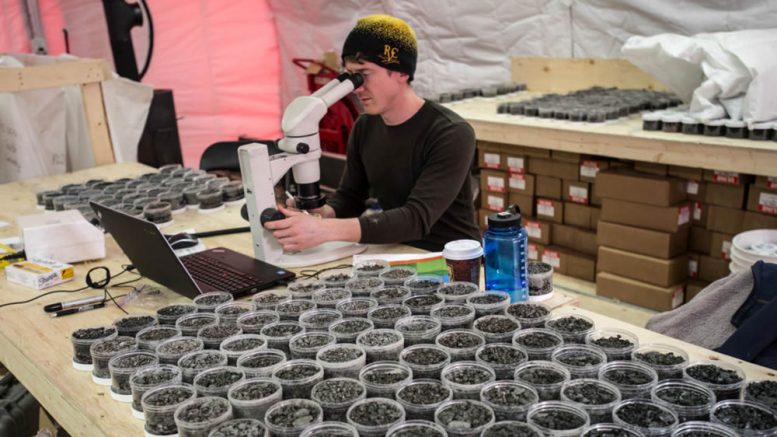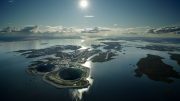For companies without the size and heft of the big producers De Beers and Alrosa, the diamond space has always been a challenging one – even before the coronavirus pandemic. But with long-term fundamentals that point to a bright future for diamonds, some juniors are finding ways to advance their projects, despite the tough times. Here’s a look at several active Canadian-based diamond explorers (and one miner), with a focus on the prospective and friendly jurisdictions of Canada and Botswana.
Adia Resources

The discovery outcrop at Adia Resources’ Lynx project in Manitoba. Credit: Adia Resources
Adia Resources is a private company held 54% by royalty company and prospect generator Altius Minerals (TSX: ALS; US-OTC: ATUSF). The company is advancing the 1,640-sq.-km Lynx project, near Oxford House, Man., where it has recovered microdiamonds not from kimberlite, but from Archean age volcaniclastic rocks.
Last year, the company completed an initial three-hole, 1,258-metre drill program at the Eastern Bay target at Lynx, will all three holes returning significant numbers of microdiamonds. From a total sample weight of 1,737 kg, 17,880 microdiamonds were recovered, with a total weight of 1 carat. That includes 12 stones that were between 0.6 millimeter and 0.85 millimeter.
The Eastern Bay target is an ultramafic unit that extends for at least 2.25 km of strike, remains open to the northwest and southeast, and appears continuous. The unit ranges from 200 to 400 metres width and has been tested to 340 metres depth, where it remains open.
This year, Adia completed seven holes totalling 2,822 metres on the Eastern Bay and Western Bay targets. Five of the holes hit the ultramafic rock the company was targeting.
Core from this year’s program has been shipped to De Beers’ facilities in Sudbury, Ont., where detailed logging and sampling for microdiamonds analysis will be conducted. Results are expected later this summer.
De Beers owned a 4% a stake in the company as of last fall, and is providing in-kind technical support on the project in exchange for shares in Adia.
Mountain Province Diamonds

The camp at De Beers and Mountain Province Diamonds’ Gahcho Kué diamond mine, 300 km northeast of Yellowknife, Northwest Territories. Credit: Mountain Province Diamonds.
Mountain Province Diamonds (TSX: MPVD; US-OTC: MPVD) holds 49% of the Gahcho Kué diamond mine in the Northwest Territories, operated by 51% owner De Beers.
The mine, 300 km northeast of Yellowknife, produced 6.8 million carats in 2019, and has continued to operate during the coronavirus pandemic. The mine plan at Gahcho Kue includes three kimberlites – Hearne, 5034 and Tuzo – and was recently extended two years to 2030.
However, after holding two diamond sales earlier this year, Mountain Province was forced to cancel its third, due to travel restrictions that shut down the diamond trade.
In June, the company closed a $50-million transaction to sell rough diamonds to Dunebridge Worldwide, a company controlled by the company’s largest shareholder, Dermot Desmond. The alternative diamond sale, which will include only run-of-mine diamonds under 10.8 carats, was approved by a committee of independent directors.
In a release, the company noted that the deal is expected to provide the liquidity required in the short term, while it waits for the gradual reopening of the global economy and traditional selling methods.
The first $22 million worth of diamonds were expected to be sold to Dunebridge on June 11. When the diamonds are sold to a third-buyer buyer in the future, Mountain Province will share in 50% of the price upside, minus expenses related to future sales costs and fees.
In addition to Gahcho Kué, Mountain Province holds 671.6 sq. km of adjacent ground as part of the Kennady North project. The project includes the Kelvin-Faraday corridor of kimberlites.
North Arrow Minerals

Taking a 200-tonne sample in July 2017 at Q1-4 while drilling continues in the background. Credit: North Arrow Minerals Inc.
With several grassroots diamond discoveries in Canada under its belt, North Arrow Minerals (TSXV: NAR) is now focused on the Q1-4 kimberlite, part of its advanced Naujaat diamond project in Nunavut.
In early June, the junior signed an option agreement with EHR Resources (ASX: EHX) to advance the project with a bulk sample at Q1-4. In return for a $5.6-million investment to collect a 1,500-2,000 tonne bulk sample next year, EHR will earn a 40% interest in Naujaat.
EHR has already transferred a non-refundable $300,000 to North Arrow in order to supply the project by sealift this year to prepare for the bulk sample program, slated to start next June. The sample will be shipped and processed during the fourth quarter of 2021, with diamond recovery results expected to follow in the first quarter of 2022. Under the deal, EHR must raise the remainder of the funds for next year’s program by next April.
In addition, the two parties have signed a non-binding letter of intent to negotiate a second agreement under which EHR can earn an additional 20% interest in Naujaat by funding a 10,000-tonne bulk sample.
The Q1-4 kimberlite is known to host rare orangey-yellow diamonds. However, a larger sample is required to determine the prevalence of fancy-coloured diamonds at Q1-4, their value, and their size distribution.
The 12.5-hectare kimberlite hosts inferred resource of 48.8 million tonnes grading 53.6 carats per hundred tonnes for 26.1 million carats.
North Arrow acquired the 107.4-sq.-km Naujaat project, which hosts a total of eight kimberlite pipes, in 2013 from Stornoway Diamond.
The company has made several diamond discoveries in Canada, including at the Mel project in Nunavut, and the Pikoo project in Saskatchewan. It also holds the Loki project in the Northwest Territories, as well as a 21% interest in the Lac de Gras joint-venture with Dominion Diamond.
Pangolin Diamonds

John Cumming (L) editor-in-chief, The Northern Miner, interviews Leon Daniels, president and CEO, Pangolin Diamonds. Photo by George Matthew Photography.
Pangolin Diamonds (TSXV: PAN) has seven projects totalling 107 sq. km in diamond-rich Botswana.
Fieldwork in Botswana ceased at the end of March due to a coronavirus lockdown in the country, but is anticipated to restart soon. In early June, the company announced it intends to raise $600,000 through a private placement.
Pangolin’s most advanced prospect is the AK10 kimberlite, which is only 4.4 km away from Lucara Diamond’s Karowe mine. The junior signed an option in mid-2018 with a private company to earn up to 75% of the kimberlite. Under the agreement, the junior is required to extract a 500-tonne mini-bulk sample at AK10 before the end of the year.
Before the pandemic, in January, it was awaiting final clearance from the Department of Mines for the program. Like Karowe, AK10 has the potential to host large (50 carats plus), Type IIa diamonds, based on kimberlite indicator mineral analysis.
Pangolin is also advancing earlier-stage exploration projects; it recently announced positive exploration results from its Kwaneng project, 20 km north of the capital of Gaborone.
Drilling at the project intersected a shallow ultramafic hypabyssal dyke with a true width of 6 metres.
The company reports that the dyke material is highly altered and is believed to be phlogopite-rich lamprophyre, similar to the diamondiferous lamprophyres discovered about 33 km away in the late 1990s.
Based on soil-sampling results that identified an 850 metre by 250-metre chromite anomaly in the area, Pangolin expects there may be more dykes nearby.
In January, Pangolin announced that an initial percussion drill program testing several targets at its 10-sq.-km MSC area within its Malatswae project returned no evidence of kimberlite, except one garnet recovered from one of the holes. Soil sampling at the project has returned 19 diamonds to date.
Talmora Diamond

The Horton River Canyon in the Northwest Territories that channelled ice on flank of Melville Hills. Credit: Talmora Diamond Inc.
Talmora Diamond (CNSX: TAI) holds the Horton River project in the Lena West region of the Northwest Territories, which it acquired in 2003.
The property has never seen any core drilling, but is being investigated as the possible source of 18 macrodiamonds found in regional samples down ice to the west and of the positive indicator mineral chemistry found regionally.
In 2018, Olivut Resources (TSXV: OLV) signed an option agreement with Talmora on a portion of the property, called the Seahorse project. Olivut can earn a 50% interest in Seahorse by completing $1.2 million worth of work to test a number of magnetic targets, and paying Talmora $200,000.
Last year, Olivut completed a detailed helimag geophysical survey, followed by a six-hole drill program completed with a heli-portable reverse-circulation drill. The junior reports that the results were encouraging.
Each of the holes intersected fine-grained clays that do not appear to be derived from the exposed dolomite country rock near the targets. While the host rock could not be identified, Olivut noted whole rock and multi-element geoanalytical results have returned complex chemistry that warrants further work.
As of last fall, Olivut had spent $1.3 million on the Seahorse project; it must decide whether to exercise its option by July 6, 2020.
Tres-Or Resources

Tres-Or Resources is planning a drill program at its Guigues kimberlite pipe in Quebec this fall. Credit: Tres-Or Resources
Tres-Or Resources (TSXV: TRS; US-OTC: TRSFF) is advancing the Guigues kimberlite pipe in southwestern Quebec, 10 km from Notre-Dame-du-Nord.
The Guigues kimberlite was originally discovered by De Beers in 1983, and passed through several owners before Tres-Or acquired it in 2003.
In the late 1980s, A 2-mm by 1-mm by 0.5-mm macrodiamond was recovered in reverse-circulation drilling at Guigues. In 2009, Tres-Or collected several small samples from the kimberlite that showed promising mineral chemistry (eclogitic garnets with diamond inclusion compositions).
Until now, however, the kimberlite has not seen modern microdiamond testing.
Last year, Tres-Or conducted a five-hole 1,432-metre drill campaign at Guigues. All five holes intersected kimberlite, with two holes ending in kimberlite at 300 metres depth. The samples arrived at a CF Mineral Research lab for analysis in late May.
Tres-Or says Guigues, which is estimated at 5 to 7 hectares in size, has similar mineral chemistry as De Beers’ Victor mine in northern Ontario. Like Victor, the potential diamond source for Guigues is marked by recovery of eclogite and lherzolite garnets that have distinctive compositions, rather than G10 garnets, as in the dominant exploration model for diamonds.
The Notre-Dame-du-Nord property that hosts Guigues also contains two other kimberlite pipes and three other kimberlite bodies discovered by drilling.
In order to advance Guigues, Tres-Or optioned its Fontana gold project, near Amos, Que., to private company Kiboko Exploration in a $6.5-million deal last year.





Be the first to comment on "Diamonds Snapshot: Six juniors staying in the game"